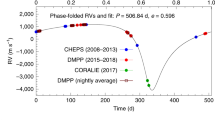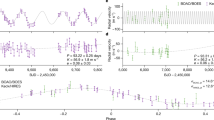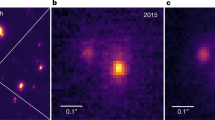Abstract
Hot Jupiters are gas-giant planets orbiting with periods of 3–9 days around Sun-like stars. They are believed to form in a disk of gas and condensed matter at or beyond ∼2.7 astronomical units (au—the Sun–Earth distance) from their parent star1,2. At such distances, there exists a sufficient amount of solid material to produce a core capable of capturing enough gas to form a giant planet. Subsequently, they migrate inward to their present close orbits3. Here I report the detection of an unusual hot Jupiter orbiting the primary star of a triple stellar system, HD 188753. The planet has an orbital period of 3.35 days and a minimum mass of 1.14 times that of Jupiter. The primary star's mass is 1.06 times that of the Sun, 1.06 M⊙. The secondary star, itself a binary stellar system, orbits the primary at an average distance of 12.3 au with an eccentricity of 0.50. The mass of the secondary pair is 1.63 M⊙. Such a close and massive secondary would have truncated a disk around the primary to a radius of only ∼1.3 au (ref. 4) and might have heated it up to temperatures high enough to prohibit giant-planet formation5,6, leaving the origin of this planet unclear.
This is a preview of subscription content, access via your institution
Access options
Subscribe to this journal
Receive 51 print issues and online access
$199.00 per year
only $3.90 per issue
Buy this article
- Purchase on Springer Link
- Instant access to full article PDF
Prices may be subject to local taxes which are calculated during checkout



Similar content being viewed by others
References
Sasselov, D. D. & Lecar, M. On the snow line in dusty protoplanetary disks. Astrophys. J. 528, 995–998 (2000)
Kornet, K., Różyczka, M. & Stepinski, T. F. An alternative look at the snowline in protoplanetary disks. Astron. Astrophys. 417, 151–158 (2004)
Trilling, D. E. et al. Orbital evolution and migration of giant planets: Modeling extrasolar planets. Astrophys. J. 500, 428–439 (1998)
Pichardo, B., Sparke, L. S. & Aguilar, L. A. Circumstellar and circumbinary disks in eccentric stellar binaries. Mon. Not. R. Astron. Soc. 359, 521–530 (2005)
Kley, W. The Formation of Binary Stars (eds Zinnecker, H. & Mathieu, R. D.) 511–518 (IAU Symposium, Astronomical Society of the Pacific, Potsdam, 2001).
Nelson, A. F. Planet formation is unlikely in equal-mass binary systems with A ∼50 AU. Astrophys. J. 537, L65–L68 (2000)
Zucker, S. & Mazeh, T. On the mass-period correlation of the extrasolar planets. Astrophys. J. 568, L113–L116 (2002)
Eggenberger, A., Udry, S. & Mayor, M. Statistical properties of exoplanets. III. Planet properties and stellar multiplicity. Astron. Astrophys. 417, 353–360 (2004)
Schneider, J. The extrasolar planet encyclopaedia. http://www.obspm.fr/encycl/encycl.html (2005).
Mayor, M. & Queloz, D. A Jupiter-mass companion to a solar-type star. Nature 378, 355–359 (1995)
Marcy, G. W. & Butler, R. P. Precision radial velocities with an iodine absorption cell. Publ. Astron. Soc. Pacif. 104, 270–277 (1992)
Dvorak, R. Numerical experiments on planetary orbits in double stars. Celest. Mech. 34, 369–378 (1984)
Holman, M. J. & Wiegert, P. A. Long-term stability of planets in binary systems. Astron. J. 117, 621–628 (1999)
Duquennoy, A. & Mayor, M. Multiplicity among solar-type stars in the solar neighbourhood. II - Distribution of the orbital elements in an unbiased sample. Astron. Astrophys. 248, 485–524 (1991)
Simon, M. et al. A lunar occultation and direct imaging survey of multiplicity in the Ophiuchus and Taurus star-forming regions. Astrophys. J. 443, 625–637 (1995)
Konacki, M. Precision radial velocities of double-lined spectroscopic binaries with an iodine absorption cell. Astrophys. J. 626, 431–438 (2005)
Vogt, S. S., et al. in Proc. SPIE Instrumentation in Astronomy VIII (eds Crawford, D. L. & Craine, E. R.) 362–375 (SPIE, Bellingham, Washington, 1994)
Hough, G. W. Catalogue of 132 new double stars and measures of 255 double stars. Astron. Nachr. 149, 65–72 (1899)
Griffin, R. F. The multiple star HD 188753 (ADS 13125). Observatory 97, 15–18 (1977)
Perryman, M. A. C. et al. The HIPPARCOS catalogue. Astron. Astrophys. 323, L49–L52 (1997)
Cutri, R. M. et al. 2MASS all-sky catalog of point sources (Cutri + 2003). VizieR Online Data Catalog 2246 (June 2003) http://vizier.u-strasbg.fr/viz-bin/Cat?II/246.
Söderhjelm, S. Visual binary orbits and masses post HIPPARCOS. Astron. Astrophys. 341, 121–140 (1999)
Zucker, S., Mazeh, T., Santos, N. C., Udry, S. & Mayor, M. Multi-order TODCOR: Application to observations taken with the CORALIE echelle spectrograph. II. A planet in the system HD 41004. Astron. Astrophys. 426, 695–698 (2004)
Els, S. G. et al. A second substellar companion in the Gliese 86 system. A brown dwarf in an extrasolar planetary system. Astron. Astrophys. 370, L1–L4 (2001)
Hatzes, A. P. et al. A planetary companion to γ Cephei A. Astrophys. J. 599, 1383–1394 (2003)
Artymowicz, P. & Lubow, S. H. Dynamics of binary-disk interaction. 1: Resonances and disk gap sizes. Astrophys. J. 421, 651–667 (1994)
Wuchter, G. Formation of giant planets close to stars. Bull. Am. Astron. Soc. 28, 1108 (1996)
Boss, A. P. Formation of gas and ice giant planets. Earth Planet. Sci. Lett. 202, 513–523 (2002)
Konacki, M., Torres, G., Sasselov, D. D. & Jha, S. High-resolution spectroscopic follow-up of OGLE planetary transit candidates in the Galactic bulge: Two possible Jupiter-mass planets and two blends. Astrophys. J. 597, 1076–1091 (2003)
Girardi, L., Bressan, A., Bertelli, G. & Chiosi, C. Evolutionary tracks and isochrones for low- and intermediate-mass stars: From 0.15 to 7 Msun, and from Z = 0.0004 to 0.03. Astron. Astrophys. Suppl. Ser. 141, 371–383 (2000)
Acknowledgements
M.K. thanks S. Kulkarni for support and guidance, D. Sasselov for discussions, and C. Gelino for acquiring the NIRC2 data. The data presented here were obtained at the W. M. Keck Observatory (operated by the California Institute of Technology, University of California, and NASA), which was made possible by financial support from the W. M. Keck Foundation. This publication makes use of data products from the Two Micron All Sky Survey, which is a joint project of the University of Massachusetts and the Infrared Processing and Analysis Center/California Institute of Technology, funded by NASA and the NSF. M.K. acknowledges support from NASA.
Author information
Authors and Affiliations
Corresponding author
Ethics declarations
Competing interests
Reprints and permissions information is available at npg.nature.com/reprintsandpermissions. The author declares no competing financial interests.
Supplementary information
Supplementary Methods
The file contains a detailed description of the novel method for precision radial velocity measurements with an iodine gas absorption cell of double-lined spectroscopic binary stars. (PDF 91 kb)
Rights and permissions
About this article
Cite this article
Konacki, M. An extrasolar giant planet in a close triple-star system. Nature 436, 230–233 (2005). https://doi.org/10.1038/nature03856
Received:
Accepted:
Issue Date:
DOI: https://doi.org/10.1038/nature03856
This article is cited by
-
The triple sunset that should not exist
Nature (2005)
-
Giant planet seeks nursery place
Nature (2005)
Comments
By submitting a comment you agree to abide by our Terms and Community Guidelines. If you find something abusive or that does not comply with our terms or guidelines please flag it as inappropriate.



